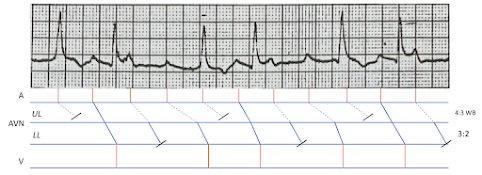Here is another great ladder diagram from Chou's Electrocardiography in Clinical Practice (6 ed), Chapter 19: Atrioventricular Block; Concealed Conduction; Gap Phenomenon.
Incidentally, this hypothesis was constructed before the Kosowsky, et al, publication Multilevel Atrioventricular Block (Circulation, Vol 54, No 6, 1976).
I wonder if we can further extrapolate the original diagram by subdividing the AV junction (or, AV node) into upper and lower level components. It may look something like this:
The basic idea is that there is Wenckebach conduction in the upper level (UL), and fixed ratio conduction in the lower level (LL). This can be tricky to appreciate, so the repeating pattern has been colorized for enhanced optics.
The first cycle of the 4:3 Wenckebach (WB) is green, then repeats itself in yellow. I assume this pattern would continue to manifest had the telemetry been longer.
The (assumed) LL fixed conduction ratio of 3:2 is demarcated in red and purple.
The opposite of this pattern (that is, fixed ratio in the UL and Wenckebach in the LL) is hypothesized here:
https://ecgladder.blogspot.com/2023/09/atrial-flutter-with-variable-block.html
























